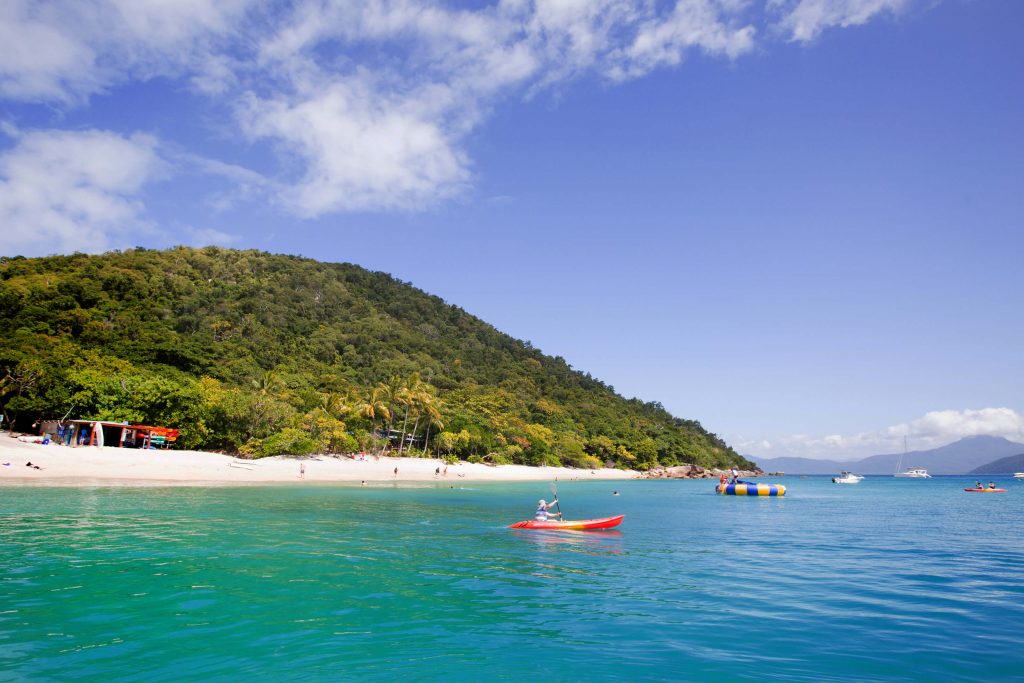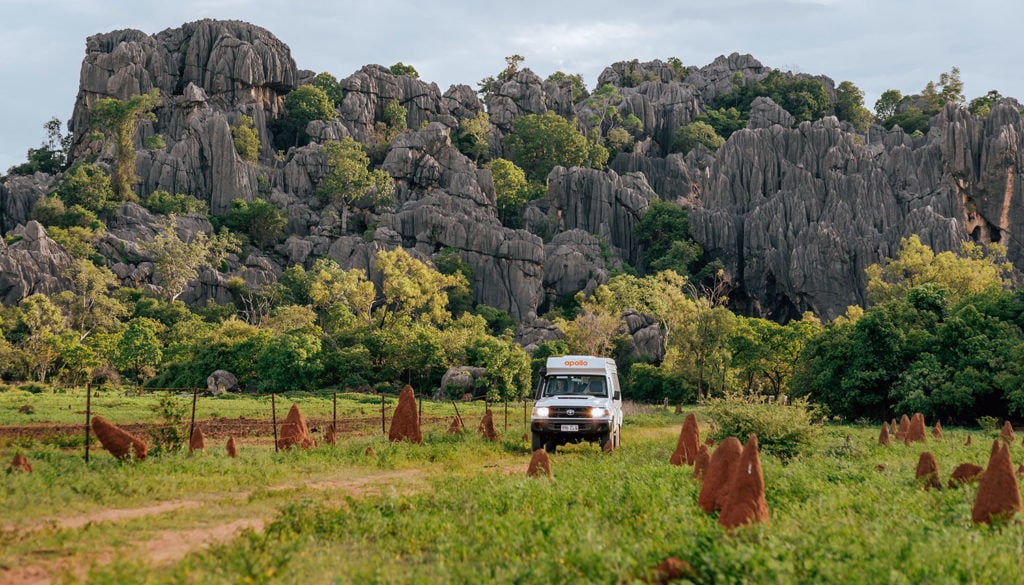TNQ Writer
Unleash your inner Robinson Crusoe by camping on the Great Barrier Reef! Have you ever dreamed of escaping from the hustle and bustle of our busy lives? Where life is simple, revolving around the rising sun and falling tide? Yep, so have we! Here’s Eight island campsites where you can unleash your inner Robinson Crusoe.
1. Dunk Island

Dunk Island
One of 12 continental islands in the Family Group of Islands, Dunk Island lies 4 km from Mission Beach. First populated by Europeans in the late 1800’s, author EJ Banfield wrote Confessions of a Beachcomber in 1907, based on the 26 years he lived on Dunk. The island has been traditional sea country of the Bandjin and Djiru Aboriginal people for tens of thousands of years.
Dunk Island Resort is currently closed which means that campers get the entire island to themselves, apart from day trippers. Hike to the summit of Mt Kootaloo for Coral Sea views, wander through rainforest or beach-comb on the sand spit at low tide. Keep an eye out for the cobalt blue Ulysses butterflies as well as vulnerable seabirds on the islet of Purtaboi Island.
CASTAWAY CHECKLIST
- Eight campsites
- Jetty Café (open Fri, Sat & Sun – weather & season dependant)
- Flushing toilets & hot showers
- Free gas BBQ’s
- Picnic tables
- Walking tracks
- Getting there: water taxi from Mission Beach
Book a campsite through Dunk Island
2. Wheeler Island

Photo by instagram.com/livin_free_everyday
Another one of the Family Islands, Wheeler offers raw, remote island camping and is popular with small boat owners and sea kayakers. Stunted woodland forest and eucalypts survive amongst the granite on the southern side. Protected from south easterly trade winds, the northern side has more lush forest.
CASTAWAY CHECKLIST
- One campsite (max ten campers)
- Bring everything & be prepared to remove your own rubbish
- Composting toilet
- Picnic tables
- Getting there: find a mate with a boat
3. Coombe Island

Photo by instagram.com/meltamblyn
If you’re looking for the ultimate island castaway experience, ala Tom Hanks in Castaway, Coombe Island is it. Only one group of campers are permitted at any one time so you’re assured of having the entire island to yourself.
CASTAWAY CHECKLIST
- One campsite (max 8 campers)
- Bring everything! (including a shovel for toilet use) & be prepared to remove your own rubbish
- Picnic table
- Getting there: find a mate with a boat
4. Fitzroy Island

kayak at fitzroy island resort
A rugged, thickly wooded, continental island southeast of Cairns, most of Fitzroy Island is National Park, with the exception of a resort at Welcome Bay. Craggy boulders and coral sand beaches line the shore. Nudey Beach is TNQ’s answer to Whitehaven Beach as ‘most photographed beach’. Snorkelers will love the inshore fringing reef near the jetty.
Campers share the island with day-trippers and overnight guests at Fitzroy Island Resort. Walking tracks cross the island but you should pack your hiking boots for the strenuous hike on the Lighthouse Circuit.
CASTAWAY CHECKLIST
- 28 campsites
- Toilets & (cold) showers
- Free Gas BBQ’s
- Picnic tables
- Cost $32 per nt max 4 pax
- Getting there: from Cairns with Fitzroy Island Resort, Raging Thunder or Sunlover Cruises
Book your campsite through Fitzroy Island Resort
5. Barnard Island Group

Photo by instagram.com/allthingspretty_leesh
Traditional sea country of the Mamu Aboriginal people, the Barnards are about 10 km offshore from Mourilyan Harbour. Continental islands which have been dated back 420 million years, they rise dramatically from the sea bed with rocky slopes clad in rainforest. Campers can bed down on Stephens or Kent Islands.
Seabirds (mostly terns) nest on Stephens Island and access is restricted to the western sand spit and camping area between September and March. The lighthouse on Kent Island was manned until a cyclone forced the evacuation of the lighthouse keeper and his family in the early 1900’s.
CASTAWAY CHECKLIST
- Two campsites on Stephens (max 12 campers), three sites on Kent (max 15 campers)
- Bring everything! (including a shovel for toilet use) & be prepared to remove your own rubbish
- Picnic tables on Stephens Island
- Poles for erecting shade tarpaulins
- Getting there: Find a mate with a boat or take a sea kayak
5. High Island

Photo by instagram.com/tayce_face
Popular with recreational fishers, High Island offers raw island camping with few trimmings. Part of the Frankland Group National Park, you’ll need to bring everything and be totally self-sufficient. You’ll need to take all your rubbish with you when you go as well as be prepared to dig your own bush toilet. Beachcombers should bring sturdy reef shoes.
CASTAWAY CHECKLIST
- One campsite (max 11 campers)
- Bring everything! (including a shovel for toilet use) & be prepared to remove your own rubbish
- Picnic tables
- Poles for erecting shade tarpaulins
- Getting there: Find a mate with a boat
6. Russell Island

Photo by instagram.com/jasonlaspina
Like High Island, Russell is popular with fishermen and castaway campers who are totally self-sufficient. Nesting seabirds also like to pop into Russell Island so the sand spit may be fenced off from humans between September and March to protect them.
CASTAWAY CHECKLIST
- Two campsites (max 9 campers)
- Bring everything & prepare to remove your own rubbish
- Composting toilet (bring your own paper)
- Picnic tables
- Poles for erecting shade tarpaulins
- Getting there: Find a mate with a boat
7. Snapper Island

Photo by instagram.com/bencourtenay
Snapper Island is a special place within traditional sea country of the Kuku Yalanji Aboriginal people who hunt and fish around the island. Please respect their culture. Part of Hope Islands National Park about 20 km north of Port Douglas, the island’s peak is clad in lush forest while mangroves border the coastal strip between beaches. The island is popular with sea kayakers.
Twitchers contain yourself please – land and sea birds love this place! Prepare to tick off honeyeaters, fantails, sunbirds, figbirds and the mistletoe bird. Keep your eyes peeled seawards for tattlers, egrets and ospreys.
CASTAWAY CHECKLIST
- Four campsites
- Bring everything & be prepared to remove your own rubbish
- Pit toilet
- Picnic tables
- Getting there: Find a mate with a boat, or book a tour with Windswell Kitesurfing Port Douglas
8. Lizard Island

On the beach at Lizard Island
240 km north of Cairns, Lizard Island is the largest in a cluster of six in the Lizard Island National Park. Poking out of the sea, 358 metres above sea level, Lizard is as east on the outer Great Barrier Reef as you get, on the edge of the Continental Shelf. If you want to be really remote, Lizard is your place! But you won’t have the island to yourself: you’ll be sharing with guests staying at the luxury resort (from 1 March 2015) and boaties.
Named after the hefty but harmless Gould Sand Monitor inhabitants, Lizard is rich in cultural significance for traditional owners and their sacred ceremonial sites and middens. The white fella has also left his mark, with the ruins of Watson’s cottage still visible at Watson’s Bay. Snorkel the Blue Lagoon as well as the Giant Clam Garden for some of the best snorkeling on the Great Barrier Reef. Follow in Captain James Cook’s footsteps on the hike to the summit of Cooks Look for an extraordinary view of Endeavour Passage.
CASTAWAY CHECKLIST
- Five campsites
- Bring everything & be prepared to remove your own rubbish
- Composting toilet
- Free gas BBQ
- Picnic tables
- Poles for erecting shade tarpaulins
- Water may be available from resort (after 1 March 2015)
- Walking tracks
- Getting there: Find a mate with a boat or contact Lizard Island Resort for flight transfer
The fine print
Camping is only permitted in designated camping areas and permits must be booked in advance. Fires are not permitted in National Parks. Fees are $5.75 pp per night. Book online at the Dept of National Parks, Recreations, Sport and Racing . Island campsites can be remote with little mobile phone coverage. Adopt the Scouts motto and be prepared!
Restrictions apply to fishing and shell collecting in the Great Barrier Reef Marine Park.













